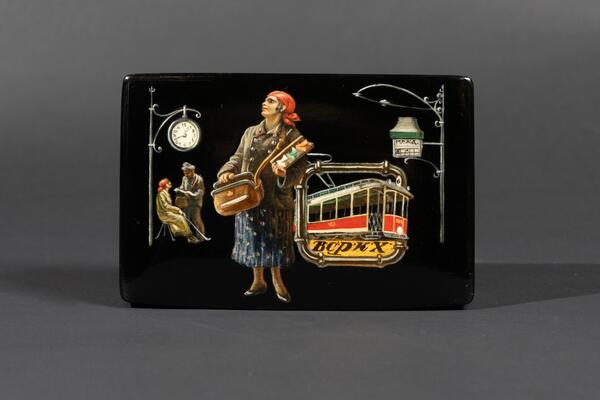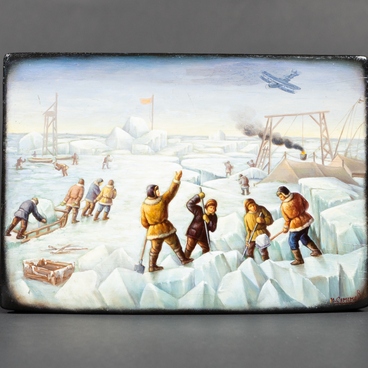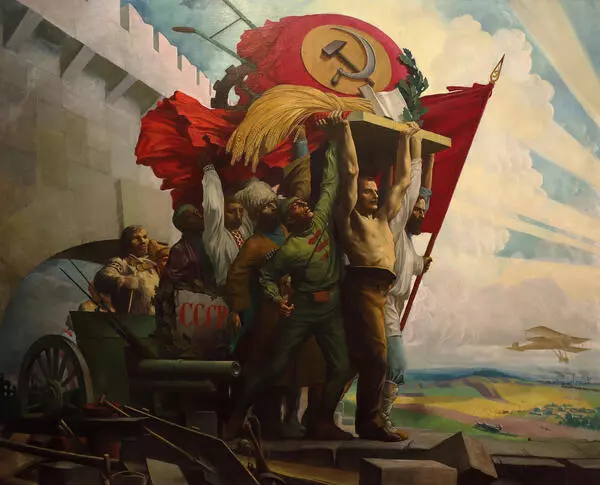The new Soviet era required new topics in lacquer miniature painting. Thus, the Central Crafts Museum in Moscow collaborated with artists from the Association of Artists of Revolutionary Russia (AKhRR). The AKhRR actively used methods of agitational propaganda (Agitprop): the masters deemed it important not only to create paintings on contemporary themes, but also to distribute them everywhere — on posters, postcards, boxes, cases and other decorative objects.
The masters of Fedoskino painted boxes according to the samples developed by the members of AKhRR, which had a great impact on the public due to their clear and expressive visual language of the posters.
The museum invited Stepan Karpov among other participants of the AKhRR. Initially, the painter was fond of mythological and historical themes, however, after moving to Moscow in 1922, he became one of the leaders of the AKhRR and turned to Realism images on the subject of revolution.
In this composition, the author depicted a full-length portrait of a female conductor in the foreground. On the right, one can see a tram and a pole with a stop sign. On the left, the artist captured a woman with a white cane who sits under a street clock, next to her is a conductor with an open book (notebook).
In this image, Stepan Karpov presented a large organization with an interesting history: the abbreviation ‘V. S. R. K. H.’ in the name of the box stands for the ‘All-Russian Union of Municipal Workers’. It was founded in 1905. Municipal workers formed ten trade unions for workers of different professions, among which were street sweepers, washerwomen, doormen, hairdressers, as well as employees of tram and bus companies.
The union’s program included demands to reduce the working day, to increase vacation days and wages, to introduce maternity insurance, as well as insurance for temporarily or permanently disabled. Subsequently, the trade union rewarded model workers and was engaged in educational activities.
Probably, the artist was inspired by the rapid development of Moscow transport system during the years of the new economic policy (NEP): the network of tram routes was expanded, tram cars which were not used during the Civil War were reinstated, and new ones were purchased.
The masters of Fedoskino painted boxes according to the samples developed by the members of AKhRR, which had a great impact on the public due to their clear and expressive visual language of the posters.
The museum invited Stepan Karpov among other participants of the AKhRR. Initially, the painter was fond of mythological and historical themes, however, after moving to Moscow in 1922, he became one of the leaders of the AKhRR and turned to Realism images on the subject of revolution.
In this composition, the author depicted a full-length portrait of a female conductor in the foreground. On the right, one can see a tram and a pole with a stop sign. On the left, the artist captured a woman with a white cane who sits under a street clock, next to her is a conductor with an open book (notebook).
In this image, Stepan Karpov presented a large organization with an interesting history: the abbreviation ‘V. S. R. K. H.’ in the name of the box stands for the ‘All-Russian Union of Municipal Workers’. It was founded in 1905. Municipal workers formed ten trade unions for workers of different professions, among which were street sweepers, washerwomen, doormen, hairdressers, as well as employees of tram and bus companies.
The union’s program included demands to reduce the working day, to increase vacation days and wages, to introduce maternity insurance, as well as insurance for temporarily or permanently disabled. Subsequently, the trade union rewarded model workers and was engaged in educational activities.
Probably, the artist was inspired by the rapid development of Moscow transport system during the years of the new economic policy (NEP): the network of tram routes was expanded, tram cars which were not used during the Civil War were reinstated, and new ones were purchased.




